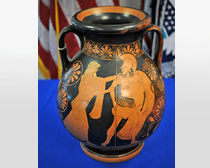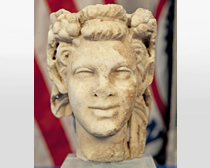 | |
| Artifact returned to Italy by ICE. Courtesy ICE |
- "9 suspects arrested in HSI probe targeting Fresno-area phony document mills"
- "637 gang members and associates arrested during Project Nefarious"
- "5 indicted for allegedly selling counterfeit goods"
While many of ICE's powerful investigative arms probe violations of federal law and pursue justice through the criminal court system, the Cultural Property, Art and Antiquities Program at HSI continues to repossess artifacts, hold repatriation ceremonies, and ship potential court evidence overseas. Arrests are infrequently announced, and indictments for violating federal smuggling, theft, false statement, or wire transfer laws are rare.
The contrast between ICE's typical approach to cultural property crimes and its customary handling of forfeited documents, human trafficking, counterfeit goods, and other illegal activities is striking. A few of this week's press releases illustrate:
- After arresting the nine men for trafficking in forfeiting documents, special agent Clark Settles said that the "goal in these investigations is to identify and ultimately dismantle the criminal organizations behind these highly lucrative schemes."
- After 637 gang members and associates were arrested, HSI Executive Associate Director James Dinkins announced that "[t]he goal of Project Nefarious was to identify, locate, arrest, prosecute and remove gang members and associates affiliated with human smuggling and trafficking organizations."
- After a grand jury indicted five people for selling counterfeit goods, ICE announced that it "plays a leading role in targeting criminal organizations responsible for producing, smuggling and distributing counterfeit products. HSI focuses not only on keeping counterfeit products off our streets, but also on dismantling the criminal organizations behind such illicit activity."
 |
| Marble sculpture returned to Italy. Courtesy ICE |
In other criminal investigations, HSI agents investigate cases, work with prosecutors to develop and sift through evidence, present the results to grand jurors, and hold lawbreakers accountable. In illegal antiquities trafficking cases, however, Homeland Security Secretary Janet Napolitano said it best during Thursday's ceremony, "We will continue to work to ensure cultural artifacts and treasures that were stolen and entered this country illegally are recovered and returned to their rightful home nations."
This "seize and send" strategy requires rethinking to coincide with the "investigate and indict" mission that other HSI investigations pursue to dismantle and deter criminal activity.
ICE Director John Morton said yesterday that "ICE is serious about reining in art and antiquity thieves, smugglers, and traffickers." Yet antiquities thieves, smugglers, and traffickers must be brought to trial. And while ICE poignantly warned in Thursday's press release that anyone "involved in the illicit trafficking of cultural property, art and antiquities can face prison terms of up to 20 years, fines and possible restitution to purchasers of the items," criminals must first be indicted before they can face such consequences in a U.S. district court. Only then can the "antiquity thieves, smugglers, and traffickers" who are targeted by ICE be held to account for violating federal criminal laws.
CONTACT: www.culturalheritagelawyer.com


_01.jpeg)